An unpublished chapter from the memoirs of Laurent Schwartz (1915–2002), about his travels in India, with an introduction by his daughter Claudine Schwartz. It has been translated here from French by Clemence Godefroy.
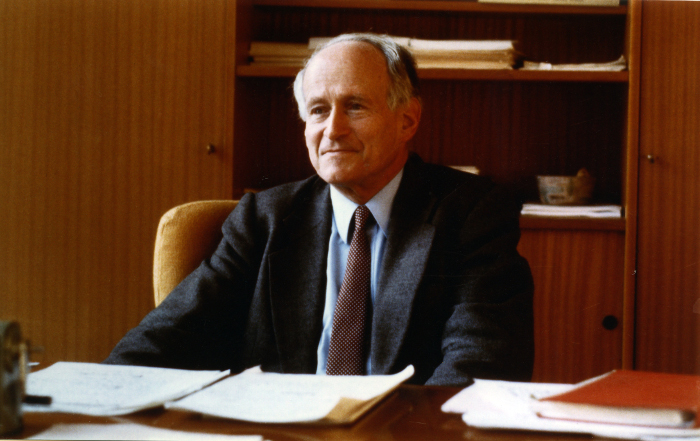
The French editor of the first version of my father’s memoirs, A Mathematician Grappling with his Century, found them to be too lengthy and asked him to cut some chapters out, notably those about his travels. This text about India, written by him around 1995, comes from this unpublished part of his memoirs.
It is a first draft and he did not quite have any prepared notes from which he wrote this, but the style is so particular to his memoirs: it is impossible to guess from one paragraph to the next what he’s going to talk about. He jumps from Kähler manifolds to giant bats, from the analysis of educational strategies to white sheets hung up in improbable places to catch moths at night, and so forth.
It gives a good idea of the type of traveller he was back then. As it is described, India is a country from another time, the same one as in Roberto Rossellini’s Matri Bhumi, which was filmed after Rossellini travelled there in 1957 (in fact, from his letters, it appears that my father may have even met him on this occasion).
This publication is also a tribute to K. Chandrasekharan, who played such an important role during his trips to India. I warmly thank the editorial team of Bhāvanā and Michel Waldschmidt who have made the publication of this document possible.
Claudine Schwartz
Paris, 25 February 2018
Itravelled to India on four occasions: in 1955, 1957, 1965 and 1974. I was alone the first time, with Jacques-Louis Lions on the second, with my wife Marie-Hélène and the François Trèves family on the third, and alone again on the fourth. I stayed two months each time, except in 1965 when I stayed for only one month. My travels in India were among those that I enjoyed the most, and I feel very attached to this country.
I met K. Chandrasekharan for the first time at the International Congress of Mathematicians in 1950; he was young back then and had just been tasked with organising mathematics at the Tata Institute of Fundamental Research in Bombay. Moreover, Chandrasekharan was a great mathematician, having specialised in the analytic theory of numbers. He told me that he would be very happy to welcome me there for two months, if I ever wanted to come. I had no idea what the situation was and talked about it to André Weil, who had spent a long time in India. He strongly recommended that I accept the invitation, which I immediately did. The trip was to last from January 15 to March 15.
Back then, as I had found out on a previous trip to Canada in 1949, plane companies showed great care and attention to travellers: I was to leave with Air India and they sent a car to pick me up at home, on 225 Daumesnil Street (Paris), and took me to the airport. However, the plane was grounded for technical reasons and they drove me back. I finally left the next day. The flight was very pleasant, and the view over the Alps was stunning.
There had been very few people invited to India before me, and at the time all guests stayed at the Taj Mahal Hotel in Bombay, which I believe was the most luxurious establishment in the entire country. It was very hot and I suffered from the heat during my stay as I had in Brazil, whereas in Mexico in 1953 it hadn’t been a problem. India has a very distinct climate but there are no significant changes in the day to day weather within a season. The rainy season is the monsoon season, and I will describe it later. It lasts from June to September. The rest of the year, there isn’t any rain, and there wasn’t a single cloud or drop of rain the entire time I was there. Every day, the sky was a brilliant blue. So even though the heat was difficult to bear, the unchanging weather made it easier to organise trips.
I immediately perceived Bombay as an ageing city which had not been properly restored. All the buildings were old, one could see it by their walls. These buildings had been built during the time of colonial Britain, and had not been rehabilitated since. The same thing can be seen in many other Indian cities—however, there are some more recent buildings in New Delhi. Right away I enjoyed tasting Indian food, even though great precautions must be taken to avoid amoebiasis—which I ended up catching during one of my trips. The food at the Taj Mahal Hotel, however, was perfectly wholesome.
The Tata Institute was right next to the hotel. The atmosphere was extremely friendly and pleasant; all the young people there were very intelligent and worked very hard, which made it a pleasure to give courses there.
I feel I must talk about Chandrasekharan’s personality, as I consider it to be quite extraordinary: he is a man of great culture and intelligence, and he has remained a faithful friend of mine with whom I exchange letters every year at Christmas. It was always a delight to see him. He has a keen sense of organisation and what he has achieved at the Tata Institute is incredible. He has a great scientific, artistic and literary culture, and his particular hobby was painting. He often spoke to me of the necessity of bringing a painting to completion: one starts, swept away by inspiration, and at first everything is fine, but then sometimes a painter doesn’t know how to finish and therein lies a serious fault. No doubt because of his artistic sense, he was also well-versed in high fashion and was thus always happy to attend fashion parades in Paris. He had been born into the Brahmin caste, the highest of all, and it showed in his education. He explained many things about India to me and we talked about a wide range of subjects. We basically agreed on political questions. The Algerian War had started in France and naturally, we had the same view on the subject. He introduced me to many people, and in general I found them to be just as cultivated in many domains. The Indian intellectual elite has a very high level of culture. I use this word deliberately: scientific considerations notwithstanding, it is in India, far more than in any other Third World country, that I have met the most intelligent and cultivated people.
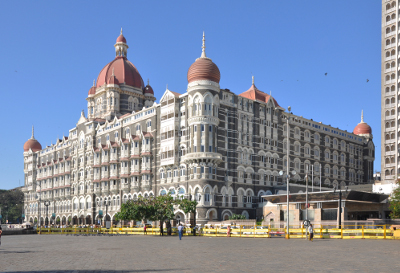
Even though there are many violent conflicts in India (between Hindus and Muslims, Hindus and Sikhs, etc), the Indians I met were very tolerant and had a more gentle and kind disposition than people in many other countries. This sometimes resulted from a certain fatalism or lack of will. As Chandrasekharan was well organised and persistent, this passivity on the part of others might have caused him some problems. He was an atheist but had great knowledge of Hindu religions and his explanations were very interesting. In his youth, he had been trained by his uncle to become a sorcerer. For example, he would heal scorpion stings by reciting sacred phrases established over several generations. In fact, it was all quite simple, he told me: these were a harmless variety of scorpions whose sting is very painful but doesn’t last more than a few minutes. A person stung by such a scorpion would come to consult the sorcerer in a state of extreme panic and suffering, and the words healed them because in reality, the pain had already gone being present only in the person’s mind. The exorcism was enough to make it disappear. Chandrasekharan’s father was not religious either, but very conservative; as a result, Chandrasekharan, who travelled throughout the world, had been banned from his father’s house as soon as he set foot outside of India, although the two of them maintained a good relationship.
The Tata Institute of Fundamental Research was founded in 1945 by J.R.D. Tata, the great industrialist; it celebrated its golden jubilee in 1995. The founding director of the Institute was Homi J. Bhabha, whom I had met in Vancouver in 1949. He too was a very intelligent man, but several conflicting views had made Chandrasekharan’s life difficult. Bhabha had taken up too many responsibilities and projects that had led him to meet prestigious people; “he takes the plane…”, as some used to say about him. And as a matter of fact, he died in a plane accident above the Alps. Just like Tata, he was a Parsi, and the former had given him the necessary funds for the Institute, as well as employed all his energy and influence to make it work.
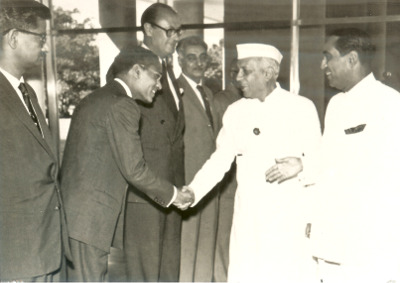
Parsis are a very small minority in India—about 200,000 out of around 400 million Indians at that time—but they hold important positions because of their fortune, their intelligence and their ambition in the noble sense of the term, as is the case for other minorities, like the Jewish people. Parsis have a peculiar way of honouring their dead: they place the bodies on top of a tower in a central area of Bombay, and leave them exposed for the vultures to feed on them. One may observe the vultures flying over that particular area as they come to eat the cadavers on the Parsi tower. I believe this is the only religion that has such a custom, which appears very strange to us. I saw vultures in great numbers in many parts of India; they are carrion-eaters and, like urubus in South America, naturally get rid of rotting animal corpses. Once a tiger has had its fill of a kill and the rest is too rotten to eat, one may observe a dozen vultures assembled around the carcass. They aren’t frightened by our presence, but then we need not be frightened of them either.
Here is the organisation of the Tata Institute as conceived by Chandrasekharan. Its goal is to recruit young mathematicians who have completed their university training and immerse them in the world of research so that they may undertake a thesis and later become real mathematicians. It’s an ambitious aim which, in my opinion, has been a success. The key is to recruit young people who are gifted in mathematics and are at the peak of their ability. Ads are published in the main universities, like the University of Madras, which became one of the principal recruiting pools of the Institute; Father Racine, a Frenchman who had spent most of his life in India, was a professor there, and he fostered some of today’s best Indian mathematicians. He sent many of his students to the Tata Institute. Chandrasekharan received around three hundred applications in response to his ads. The majority were considered as null, leaving around seventy serious applicants. He planned on admitting between five or ten students a year, which in itself is a promising start! The seventy applicants received a summons to Bombay, all on the same date, and the oral examination lasted several days. Each applicant was interviewed and tested for any length of time between half-an-hour and an hour-and-a-half. Often, a younger member of the Tata Institute, Babla Vinayak Singbal, would help Chandrasekharan with this examination. I knew him well back in 1955 and he was a brilliant young man, but, sadly, he died of a heart attack rather young at 54.
Having arrived before the beginning of the school year during my second trip in 1957, I can precisely explain how this exam was organised. Chandrasekharan asked me to attend the exam alongside himself and Singbal. He wanted me to have a clear view of the situation and I was both amazed and baffled by the experience. On the one hand, there were students who clearly stood out and who had worked on many mathematical problems during their university studies, and thus were ready to engage in quality research. For example, it was the same year the Institute recruited Raghavan Narasimhan, who became an excellent mathematician of international calibre and now lives in the United States.1 On the other hand, there were a large number of young people who already held teaching positions in Indian universities but whose level was completely inadequate. I was stunned. It was nothing new for Chandrasekharan but he thought I should see it for myself, not in the intention of denigrating his own country but to show me how much progress needed to be made, and what role the Tata Institute could play for India.
The first questions were of the following sort: “What is a continuous function?”, “Give an example of an irrational number.” Some answers were appalling: “A continuous function is a function that cannot go from one value to another without going through all intermediate values.” “A continuous function is a function that can take all values.” “So,” Chandrasekharan would ask, “is the constant function 1 continuous?” Answer: “No.” And these were people teaching in universities! As for irrational numbers, they all gave the same example, \sqrt{2}, and they knew how to prove it. But when Chandrasekharan asked if \sqrt{3} was irrational as well, they couldn’t manage a demonstration. The definitions of the derivative and the integral were totally far-fetched as well. In those cases, he didn’t insist and the exam was very brief. But in the case of Raghavan Narasimhan, he certainly made him work for a long time, and Raghavan Narasimhan perfectly proved the prime number theorem by using the \zeta(s) function. However, even more than knowledge, Chandrasekharan was looking for innovation and intelligence in the minds of the students. Amongst the candidates of 1957, there was a very young man that Father Racine had described as “a pure soul”; even though he had been offered a hotel room, he had arrived at the Institute after sleeping in the street the night before. True, it is quite frequent in India, and the streets are filled with homeless people sleeping outside; during monsoon season, they take shelter under porches. Students admitted to the Tata Institute were warned from the start: there was to be no question of castes during their stay there. They would work together and eat together without any distinctions. They all followed the rule without any problem.
In 1955, my lectures were attended by around fifteen bright, well-trained students. Two of them, Singbal and Mudumbai S. Narasimhan, were in charge of transcribing my lessons; M.S. Narasimhan has remained a very good friend of mine. Following an ancestral custom, his bride was chosen by his uncle and not himself, but the choice was excellent and they have had a happy, successful marriage. Shortly thereafter, Singbal and Narasimhan were invited to France to work with me. Narasimhan quickly developed a mild case of tuberculosis, detected only by the preventive tests of our university system; he was a vegetarian and at the time university restaurants were not at all equipped to offer proper vegetarian menus. Since then, he has accepted to eat meat. Chandrasekharan is also a vegetarian, not out of respect for religious tenets but because he has been accustomed to this diet since his childhood and he has no taste for meat. Marie-Hélène and I were invited to his place many times and his wife always welcomed us with great kindness and hospitality; we always had excellent conversations and the vegetarian meals were excellent as well.
The students at the Institute had to work very hard; after a personal evaluation, each of them had to follow certain courses. There were always a large number of these: I gave two or three classes a week, and there were two other guest speakers there at the same time—Hans Maass, a German professor, and Hans Rademacher, an American professor, who were both known for their first-rate work. As a matter of fact, I also attended their classes. The students worked on the classes together and, as I said, it was Singbal and Narasimhan who transcribed my course. Naturally, I corrected it afterwards and it was then published, just like all the other courses given at the Institute, in a particular collection whose reputation quickly spread around the world. That year, I gave my class on analytic functions of several complex variables and on Kähler compact manifolds. Among the brilliant students I met during my stay, there was also C.S. Seshadri, whom I introduced to complex analytic manifolds.
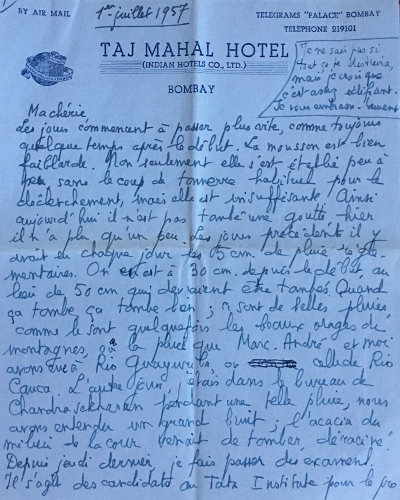
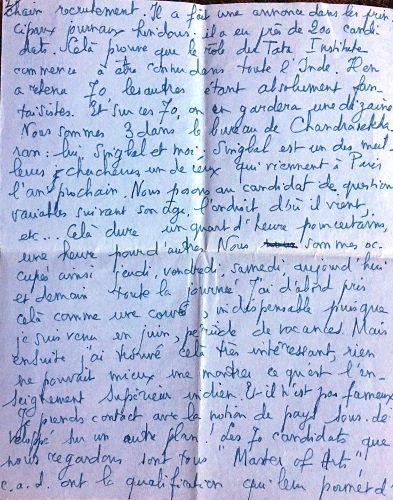
Sample of a letter written by Laurent Schwartz from India Claudine Schwartz
The effort the Tata Institute put into the mathematical training of its students was formidable: university professors of remarkable talent were invited from all around the world, totalling thirty months a year in the number of their collective working hours. I always greatly enjoyed giving lessons there and engaging in discussions with everyone. The secretary of the Institute organised everything with remarkable efficiency and was very friendly. He was a poet, and I think he wrote his own poetry on top of being well-versed in Indian poetry. He asked me if I could bring him some works on French poetry; unfortunately, he thought French poets had written their poems in English and, since he didn’t understand French, he gave up on the idea! I saw the same sort of attitude on other occasions, when people thought that university classes were given in English in Paris, as they were in their own country.
Itravelled throughout India on many occasions, with Maass and Rademacher in 1955, and sometimes by myself in later years. I generally followed Chandrasekharan’s recommendations, and I won’t describe everything I saw, as others have written about the wonders of India. However, there are some of them I would like to say a few words on. In the Bombay area, I visited Kandala, where there are beautiful bronze statues of the Buddha with incredibly gentle smiles. I also saw an interesting thing there: large caves whose ceilings are the natural habitat of gigantic bats called “vampires” even though they only eat fruits, and which weigh several kilos. When you enter the cave where they are hanging from ceiling, and they all take flight at the same time and you find yourself surrounded by squirming but harmless vampires.
In the region of Madras, I had the chance to admire the Mahabalipuram sculptures, a wonderful variety of human and animal figures sculpted from a huge rock. The heat was intense there: the “cool” water in my bathtub was too hot for me to get in. In the north east, the temples of Bhubaneshwar and Konark are home to a series of representations of romantic and sexual relationships which are quite sensational. And finally, out of all the wonders surrounding Agra, near New Delhi, I will only mention the Taj Mahal, one of the most magical places I have ever seen. Its shape is stunning, especially against a bright blue sky, or under the moonlight at night. The colourful mural engravings are of delicate flowers, in contradiction with the Islamic law which forbids to represent living beings. The first time I visited, there weren’t crowds of foreign tourists like there are today, and there were only about twenty people present on the entire site; when I returned a second time, there were hundreds of people on the length of the path alone. What can be done? Those are the rules of democratisation, but the emotion I felt at the Taj Mahal in 1955 was never the same. My first visit to the Taj Mahal remains one of the greatest days of my life.
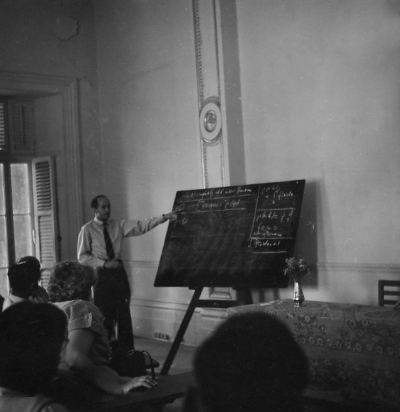
Of course, I gave a few lectures at the University of Delhi. The university was filled with monkeys: they entered the student dorms if the windows were left open and ripped up the papers. There were also cows on campus; one evening, I had a hard time entering my room because a cow and its calf were lying in front of the door. As everyone knows, the cow is a sacred animal for Indians. There are more than a hundred million cows in India. Indians don’t eat them even though they often suffer from malnutrition, and it is quite cruel towards the cows who have nothing left to eat in the dried up fields before the rainy season starts. Many of them come to die of hunger in the cities.
Once, I travelled from Calcutta to New Delhi by plane. The trip was breathtaking, as we flew above the Himalaya for several hours. Naturally, I also went to see the exquisite paintings of Ajanta and Ellora, which I visited twice, once in Marie-Hélène’s company. The paintings represent scenes from Buddha’s life; in one of them, his wife is leaning against a wall, her foot and her leg forming a curve, her face expressing dismay as her prince explains that he is renouncing the world, to become a wandering ascetic, the path that will eventually lead him to divinity. All these paintings and sculptures are incredibly expressive.
I would have loved to spend a week in Ceylon to see its gorgeous landscapes, but in 1955 Ceylon was under the authority of the British Crown and when I requested a visa at the British embassy, they told me they didn’t want to grant me such an “easy access”! Today, Ceylon has become an independent country, Sri Lanka, but I haven’t had the opportunity to go there.
I took a liking to Indian music and even more to Indian dance, and saw several concerts and dance shows. Asian dances are very graceful and are composed of hand, arm and leg movements which can be admired in its entirety and studied in detail as well. I saw many of these dances in India, Cambodia and Thailand. The same grace can be found in the bronze statues of these countries, and I often think of it. I believe the most beautiful bronze statues of India can be found in the Museum of Calcutta: I spent hours looking at them. In my opinion, the huge, white, pyjama-like sheets men often wear are most unflattering, but saris and shawls are very beautiful. All Indian women wear saris, even though they’re a bit complicated to put on, and these garments give them a serene, majestic air. Once, when we were having dinner at Chandrasekharan’s house, his wife, always the most pleasant of hostesses, successively tried on several saris to show them to us and it was magnificent.
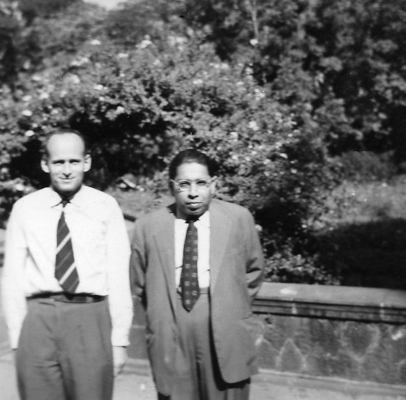
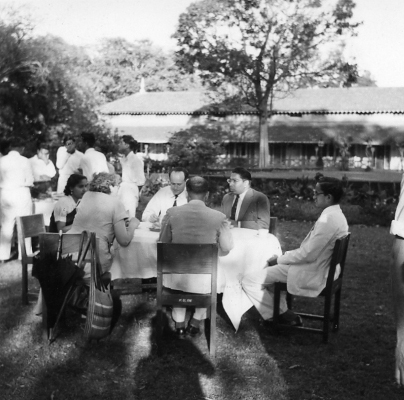
Some time ago now, Chandrasekharan retired from the Tata Institute to go teach in Zurich; he wanted the younger generation to come into its own. His successors were very efficient in their job. However, there is a flaw in the way the Tata Institute works: students are paid and if they stay at the Institute, they have a much better salary than anyone teaching in an Indian university. Furthermore, because of jealousy and envy, these universities will not often employ them. It’s a flaw I warned Chandrasekharan about and which was very difficult to set right. The students, who have been trained and are now quite numerous as they were admitted into the Institute at a rate of a dozen per year, have nowhere else to go—but neither can they all stay put. The problem has been solved in part because the Tata Institute has created an annexe in Bangalore, and has good relations with the University of Bombay. Nevertheless, it’s still not enough and they have had to stop recruitments in certain years. I wished for the Tata Institute to have the same role as the Ecole Normale Supérieure in France: to train new researchers each year, who will then work in great universities and scientific research centres throughout India. The entire scientific structure of the country would have then changed. But to reach that goal, a certain number of dispositions should have been taken, like giving certain privileges to the alumni of the Tata Institute in universities and research centres. Once I wrote to Mrs. Indira Gandhi to suggest this but received no reply, which is a shame as Chandrasekharan knew her well. Today there are former members of the Tata Institute teaching in mathematics departments all over the world, contributing to the scientific development of Western countries! And all for the same reasons as in other Third World countries: few Indian universities could give brilliant scientists the same comfortable and stimulating working conditions as their Western counterparts. To achieve this would require reaching a certain threshold, which the Tata Institute could have contributed to after a difficult start. And so, the Indian mathematicians J. Choksi, K.N. Gowrisankaran, both alumni of the Institute, and the Colombian mathematician B. Nieto, trained by John Horváth during his stay in Bogota, all teach students in Montreal! (It is Choksi who, along with Horváth, helped me write my book Radon Measures on Arbitrary Topological Spaces and Cylindrical Measures, published by Oxford University Press, which arose out of the lectures I gave in Bombay during my stay in 1965.)
I am an honorary member of the Indian National Science Academy and the Tata Institute, which means I can invite myself there whenever I want. I must say, though, that I’ve never taken advantage of this privilege. I travelled to India four times and would have loved to return there more often, as it is a country I dearly love, but I love so many countries that it was the best I could do. In 1957, I came during the monsoon season in July, August and September. The heat and humidity were excruciating. The rain is truly formidable: ten centimetres per day in Bombay before progressively diminishing. This makes a total of six metres of rain per year, compared to seventy-five centimetres in Paris. The monsoon slowly travels from south to north. Before it arrives, the sky is covered with dark, low-lying clouds, and it finally bursts in an incredible storm, even though not a single drop of rain has fallen beforehand. Then it rains every day, with a major rainfall that stops only to start again every half-hour. I came back during the monsoon with Marie-Hélène in the summer of 1965. This wasn’t the season I enjoyed most but Marie-Hélène had also been invited at the Institute to give a course series, “Stratification of complex analytic sets”, with the collaboration of Miss Rajwade, an intelligent young woman, and Raghavan Narasimhan, whom I spoke of before, for the transcription of her lectures. I had been able to take a leave of absence during the school year for my previous travels, but Marie-Hélène’s work at the University of Lille gave her no such freedom. As it happened, I had caught histoplasmosis in Peru a few months before; I was still very tired and the climate of India made it worse. I was unable to stay for the two months we had planned on, and returned to France after only one month, leaving behind Marie-Hélène but also Trèves and his family. Trèves’s first son was born there, and this created a world of problems for his civil registration. Indeed, Trèves was born in Italy, and so was an Italian, and his wife was German. If the baby was registered as an Indian citizen, his caste had to be given, which was impossible. To register him as an Italian citizen, Trèves had to provide a religious marriage certificate, which they couldn’t. Finally, they registered the baby as an Indian citizen without indicating his caste. Of course, following the efforts of Mahatma Gandhi, progress has been made on the issue of castes; they have now no official recognition, even if they are still very much present in the minds of the people. Every morning, I read the Times of India, a remarkable newspaper, and would see some marriage ads: sometimes it was written “caste not important”, but other times, it was clearly very important.
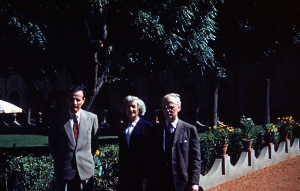
The city of Calcutta is a difficult place to visit because of its immense poverty: the streets were full of beggars and paupers, often dying where they lay. The traffic was slowed down by homeless people and cows in the middle of the road. It is said that Mother Teresa, by giving shelter to a great number of the beggars of Calcutta, saved the lives of many of them and has given the city a more humane appearance. But there are still scores of beggars everywhere. Some of them trail behind you for a very long time, asking for a little money. One time in particular, three young girls, who had lost fingers or hands because of leprosy, followed me for quite a while, touching me with their stumps. In fact, I had given them money, but it wasn’t enough! Another time, I gave “too much” money to a rickshaw driver, and right away he asked me for more and tagged along after me for ten minutes. Tourists always give “too much” (that is, compared to wealthy Indians who almost never give anything), and those who earn a living with these odd jobs are quite miserable. I had the same sort of trouble with little shoe-shine boys: one of them poured something on my shoes without me noticing so that I would have to ask him for a shine. When I talked with other tourists, I learned that this was a common practice. Mendicancy exists all around India because it is both a poor and a very populous country. Birth rates were incredibly high. The desire to have at least one male child meant having at least two children, and because of infant mortality, it was safer to have six. Progress in medicine and hygiene led to a drop in infant mortality, but the number of births stayed the same. In 1955, there were about 400 million Indians (to an idiotic journalist asking how many problems there were in India, Jawaharlal Nehru replied that there were 400 million of them), and today there are more than 900 million. The hotel in Bombay was always surrounded by droves of beggars, and each day the same people came to ask money from us; sometimes I gave them something, but others I told them “No, I gave you money yesterday, don’t you remember?”. Mendicancy is a well-organised trade: for example, there were several little girls begging in front of the hotel. One of them would come see me with a baby in her arms, then would run and hand over the baby to another girl. The poor infant was carried from tourist to tourist. The organisation of mendicancy is similar to that of the Middle Ages in Europe and is very cruel to children, who are sometimes mutilated on purpose so that they will bring in a few rupees by begging. Sometimes beggars show a real sense of humour and true kindness: once, a dozen of little boys and girls were following behind me after I had given them each something, and all of a sudden they all cried out at the same time to scare me. I turned around and they burst out laughing, and so did I.
There are thus great inequalities in Indian society. Between a Brahmin and an Untouchable, what a world of difference! Thanks to the work of Mahatma Gandhi and Jawaharlal Nehru, the situation of the Untouchables has much improved; they take part in the political life of the country, even though they still live in a state of misery. Yet India remains one of the only democracies in the Third World—a democracy in which there is widespread corruption, in the Congress party as in all upper echelons of society, but a democracy nonetheless.
In the poorer classes, the situation of women is wretched. In certain places in the past, a wife had to throw herself in the funeral pyre of her husband. For all intents and purposes, this practise has been abolished, although I’m not entirely certain there aren’t isolated cases here and there (which would be severely repressed anyway). But the fate of widows has always been very harsh, and perhaps it remains so. In high society, however, women have a prestigious role and participate in all kinds of social activities; they don’t very often have careers of their own, but there are quite a few female scholars, for example. In any case, they are very cultivated and very gracious. The marriage ads in the Times of India insisted on the necessity for a potential wife to be refined and learned in arts, literature and music. One may say this is the traditional division of gender roles: the man is an engineer or a banker, and the woman a pretty ornament. (Yet any comparison with the role of women in the neighbouring Muslim countries doesn’t bear mentioning.) And in France, a person claims to be cultivated if they are learned in arts or literature, but take foolish pride in being bad at science. If a majority of Indian women in high society didn’t have a profession in 1955, the same was true for French women of the same status. A beautiful Indian woman in a beautiful sari is a wonder to behold. I saw women bathing in the sea wearing their saris, which seemed very impractical. There were often receptions at the Taj Mahal Hotel and you could see a number of couples coming in, with lovely women in saris. I stood near the entrance to watch them go by. I told Lions I was admiring the saris, and Lions maintained I was admiring the women, and I think both were true.
Naturally, I came to buy silk shawls in scintillating colours, for example in deep blue or vivid “peacock” green, cashmere shawls and jewellery, like bracelets and necklaces of silver and jadeite. Once I bought two saris, one each for Claudine and one of my nieces. A dressmaker transformed them into ball gowns and they were overjoyed. I spent many afternoons wandering around shops filled with antiques and decorative objects. I have no flair for bargaining, unlike the shop owners. They would tell me, “This is worth a hundred rupees, but for you, sixty!”—and they didn’t even know me! After my first trip, I came back with twenty-five presents, much to everyone’s delight.
Let us now talk about natural history. As soon as I arrived in 1955, I contacted the BNHS, the Bombay Natural History Society. There are some remarkable naturalists in India. One of them, Humayun Abdulali, became a particular acquaintance of mine and accompanied me on several naturalist expeditions. He was a top-notch expert on amphibians and reptiles, and revealed many astounding secrets to me. Once, when we were riding in a car at night, he saw a small snake on the road and he immediately asked the driver to stop. He ran towards the reptile, but instead of placing his foot on its head, he stepped on its tail and the snake bit him. Fortunately, it was not a venomous snake. I asked him how he could have done this without knowing what kind of snake it was; he replied he knew perfectly and had immediately identified it in the dark. This was only partly reassuring, as he had still mistaken the head and the tail of the snake. He told me all about different snake species, cobras and pythons in particular. As I mentioned before, I saw several pythons but never saw any cobras. The king cobra is five or six metres long; it is a terrifying beast, lunging at whoever gets too close and capable of great speed. I think the ordinary cobra is no longer than a metre or a metre-and-a-half; it has the same venomous characteristics as an American rattlesnake but it is far more common. Since many Indians living in the countryside walk around barefoot, there are hundreds of deaths caused by snake bites every year.
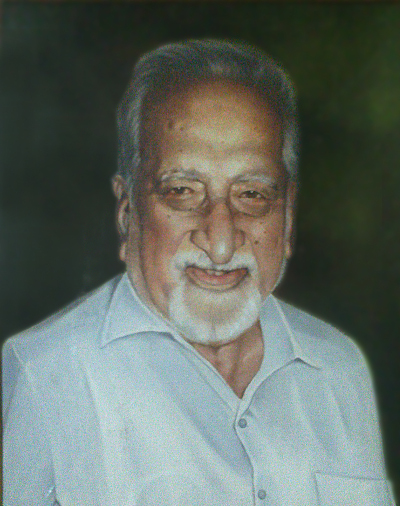
Humayun invited me to watch a harvesting of cobra venom, used for biological purposes or to create a cure for people who have been bitten. We entered the cobra farm of the laboratory and one of the men opened a cage. When the cobra wasn’t looking, he put his foot on its head, grabbed the cobra by tail and pulled it up: if it is handled this way, the cobra can no longer raise its head. He then put a glass within reach of the cobra: it bit the glass and poured its venom into it. The man wasn’t immune but he had anti-venom serum within reach in the laboratory. It is well known that the mongoose is a particularly dangerous adversary for the cobra. The mongoose is from the same family as weasels and martens, Mustelidae, and it is a first-class carnivore with razor-sharp teeth and swift moves. When a mongoose meets a cobra, there are nine chances out of ten that it will kill the snake and eat it. The cobra lifts its head high up the ground to hover over the mongoose and threaten it, but the mongoose moves quickly from left to right, so quickly that the cobra cannot keep up. If it were to lunge at it, it would most certainly miss. This goes on for some time until the mongoose perceives the cobra is tiring and slowing down: at that moment, it jumps at the cobra’s neck, killing it on the spot. I wanted to know if the mongoose was immune to the cobra’s venom but when I asked around, I only got contradictory answers. Everyone knows the famous mongoose from The Jungle Book, Rikki-Tikki-Tavi. A number of Indians who don’t want a cobra to slip into their garden take to raising a mongoose. Cities are filled with snake charmers but it is a sorry sight. During his show, the snake charmer releases a mongoose on the snake: it instantly makes for the snake’s neck, but isn’t given enough time to kill it. However, this certainly harms the snake, and I find it sad in the sense that the poor snake has been bitten innumerable times by the mongoose and stunned into a stupor. Snake charmers usually carry anti-venom serum with them but I have heard of one being killed by his cobra.
Thanks to Humayun, I discovered an extraordinary species of fish. On top of a three-or four-hundred-metre hill, during the monsoon season, he showed me a small pond filled with tiny fish which were a few centimetres long. “What do you think these fish do during the dry season, when there is no more water in the pond?” he asked me. I was stumped. He then showed me that the rocks along the road we had taken to come there were humid and that water dripped from them constantly. The little fish would climb up the rocks, sticking to the surface through viscosity, and thus travel up to the top of the hill. Throughout the trip, Humayun would sometimes get out of the car and go examine a birds’ nest under a bridge that he had always known to be there. As I said, Indians are keen on animals, and I have known their interest in tigers in particular. They are just as interested, if not more, in elephants. Every once in a while, there is in fact an elephant census carried out with extraordinary meticulousness. The date of the census is given months in advance and on that day, all the employees of the Wildlife Commission appointed to the task go visit the herds whose location they know well, count the elephants and calculate the total, give or take a few tens. The BNHS publishes two books several times a year: one contains articles on the topic of natural history, systematics’ descriptions, and thorough studies of animal behaviour. The second one, entitled Hornbill, is much smaller and contains gorgeous pictures with more interesting animal behaviour studies. They are the two best natural history periodicals I know of.
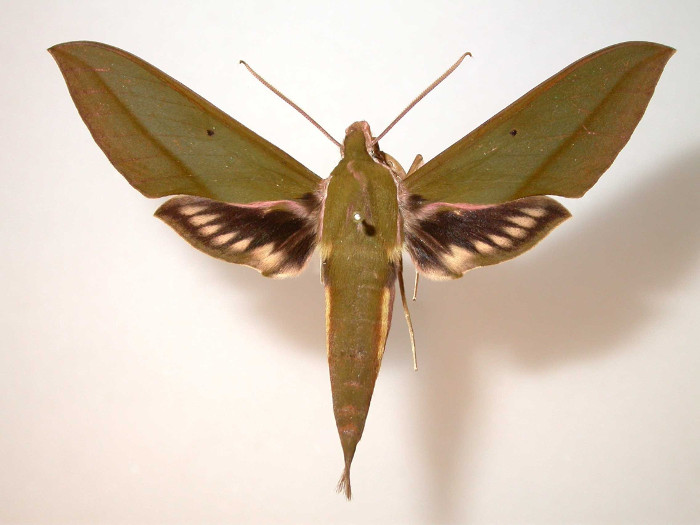
I am now a life member of the BNHS. Sadly, they somewhat disappointed me on the subject of butterflies. There are very few butterfly collectors in India, and I had to find them myself, as the BNHS could not put me into contact with a single one of them. I visited the butterfly collection at the Museum of Bombay, which is only just adequate: it includes most interesting Indian butterflies but none from other countries. The curator is very careful but the collection is preserved in a bizarre way given that India is such a hot and humid country, and the butterflies tend to disintegrate, rot or get eaten by parasites. They should have been displayed in cases with air-conditioning, which is used in all the major hotels in the city. I also wrote on this topic to Mrs. Indira Gandhi, without success. Naturally, they don’t have a list of what they possess, but admittedly this is the case for French natural history museums as well, including the one in Paris. The lack of funding and students willing to take up biological systematics is a phenomenon present not only in India but in France and many other countries too. Yet some American museums raise the bar in the field, and whereas there is practically no air-conditioning anywhere in Vietnam, they use it to preserve the insect collection of their natural history museum. It was even used in deep underground chambers where the collection was stored during the Vietnam War.
Nonetheless, the Society did help me on a short trip I made in the Nilgiris mountains, in the southern part of the country. I was almost always unlucky in my search for butterflies in India. In 1955, it was winter and the dry season, and there was nothing. At the Museum, they told me that “the monsoon was good for the butterflies and moths”. Therefore in 1957 I came back during the monsoon, in the summer: the rain was so torrential there was nothing then either. The only entomologist I found, Mark Alexander Wynter-Blyth, the retired author of a good book on Indian butterflies, told me: “You are in-between seasons.” I should have guessed that there were only two good seasons, like in Brazil: just before the monsoon, in May or June, and right after it, in September and October. However, he did tell me that July and August were alright, if not the best season, in the Nilgiris mountains, and so there I went in 1957. Furthermore, the best region for entomologists is undoubtedly Assam, but it is forbidden to foreigners as a semi-guerilla war is taking place there. And to top it all off, butterfly hunting has been forbidden to foreigners for a few years now, unless a permit is given by the Fish and Wildlife Service, on the condition that you give in advance the species and the number of butterflies you plan to catch, which is ridiculous! True, it is relatively easy to bypass this condition. But let’s get back to the Nilgiris mountains.
The Society traced my itinerary and called up each stopover where I would be staying so that someone would take care of me, a boon in a country where most people don’t know how to speak English. Two of my stopovers during this trip must be mentioned here. The first was Kallar, which Wynter-Blyth, a good entomologist, had described to me as a paradise of butterflies. And so it was. In two short hours, I found hundreds of specimens of Papilio crino and Papilio polymnestor. I was literally surrounded by them, and their dazzling blue and green wings were fluttering all around me, yet I only managed to catch very few. The place was filled with lantana flowers and the butterflies landed on them all the time, but always out of reach; they never landed close enough or long enough for me to catch them in spite of all my strategies, and they can fly away very quickly. I must have brought back half a dozen of each specimen, which is nothing compared to the amount I saw. This happened in 1957, back when I didn’t yet know butterflies were attracted to coloured paper. If I had used this, I no doubt could have brought back many more.
In Kallar I also made an interesting night-hunt off the property of an engineer I didn’t know; I had simply asked him if I could spend the night at his place and hang my lamp on the side of his house which had a plunging view on the jungle below. He had refused at first, which is understandable, but when he found out I was a university professor, he immediately said: “Well, in that case, there’s no problem at all, and I’m inviting you to dine with me and my wife as well.” We talked about all sorts of interesting things and they were delighted that I was so fascinated with Indian art. “Tourists speak generally about India as a country with tigers and snakes,” said his wife. I understood her perfectly. Tigers and snakes were by no means the only things I found interesting. My night hunt was quite successful, which amazed them. “I never imagined there were these sorts of butterflies right next to my home,” the engineer said. Indeed, there were several gigantic moths too, Attacus atlas, and some Actias, of a startling green colour he had never seen before. From their house, you could also spot many monkeys in the trees of the neighbouring jungle.
The second stop was Mudumalai, where I was accompanied by two young researchers linked to the Tata Institute who worked in the Nilgiris mountains. First of all, I went on a wonderful night hunt where I caught two very interesting Sphingidae species: Marumba nympha and Ambulyx matti. Secondly, I had an amazing experience with elephants because there is a sanctuary in Mudumalai: a number of elephants are raised to help tend the forest of teak trees, which provide high-quality hardwood. You can often see elephants working together to transport heavy lumber with their trunks. One morning I was given the chance to climb atop one of the elephants and ride through the jungle for a few hours with one of the two scientists and the mahout. They wanted me to encounter a tiger, which of course would have fled when faced with the elephant, for it is entirely capable of wrapping a tiger in its trunk and flinging it against a tree, shattering its bones. Once, it happened that a tiger made an incredible jump over an elephant’s back to catch its passenger and carry it away, but these kind of exceptional feats are not to be feared. However, I read in Hornbill a pitiful story from someone who had witnessed a tiger attacking a young elephant and killing it almost on the spot. Right away, a female elephant ran at the tiger to chase it away. As a matter of fact, females live in small communities where each one of them looks after all the young. The female desperately tried to make the young elephant rise to take it back to their dwelling spot, but it was unable to stand up because of its extensive wounds. After several tries, the female left to spend the night further uphill, and the tiger came back to finish off the young elephant and eat it. It was simply too heavy for the mother to take it higher up the mountain. During my elephant ride, I didn’t see any tigers, even though we spotted some fresh tiger prints near a stream, made by a tiger during the night as it came to drink there. We saw a herd of antelopes, but nothing more.
Crossing the jungle is an interesting experience but you must be careful; indeed, the elephant avoids branches which are in its way but it doesn’t know how to avoid branches which are in the passenger’s way. At one point, I asked the mahout to order the elephant to fell a tree, and he did. All on its own, the elephant chose a massive tree, whose trunk was well around thirty or forty centimetres wide. It calmly walked over to the tree, pressed its large forehead on the trunk, and slowly pushed forward with no apparent effort. The tree yielded little by little, then was uprooted and fell. It looked so easy that for a moment I thought I might do the same myself—a rather curious illusion! The memory of the Nilgiris mountains stands out vividly in my mind.
I spent describing my travels to India more than those I made in many other countries, and that is because they left such a strong impression on me. It would be an exaggeration to say that I feel at home in India like I do in France, but there is a part of truth in this that is hard to explain. Each time I arrived in India (my first trip there was forty years ago), there was a familiar atmosphere, just like at home. I know that I am a citizen of the world, but some countries are more like home than others: France, of course, the United States, Quebec [Canada], Brazil, Vietnam and India.
Footnotes
- Raghavan Narasimhan passed away in October 2015. ↩
